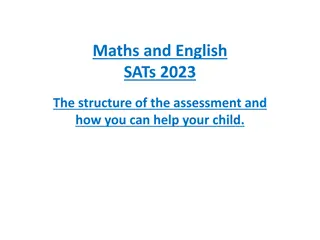Fun Maths Activities for Year 5 Students
Engage your Year 5 students with fun maths activities including warm-up exercises, place value charts, division practice, and varied fluency challenges. Mrs. Bowring encourages students to keep learning and have a great time while doing so!
Download Presentation

Please find below an Image/Link to download the presentation.
The content on the website is provided AS IS for your information and personal use only. It may not be sold, licensed, or shared on other websites without obtaining consent from the author. Download presentation by click this link. If you encounter any issues during the download, it is possible that the publisher has removed the file from their server.
E N D
Presentation Transcript
Monday 30/03/2020 Year 5 Maths Hi My Lovely Year 5 s!!! Just a little something to make you smile in week 2!! I hope you re all being good students for your parents!! Look after yourselves!! Mrs Bowring
Warm up / get your brain ticking Warm up / get your brain ticking ideas! ideas! Choose either or both!
Complete in your exercise books: What numbers are shown on the place value charts below? T Th Th H T O T Th Th H T O
What numbers are shown on the place value charts below? T Th Th H T O 33,500 T Th Th H T O 2,363
Varied Fluency 1 Match each statement below to the correct answer. T Th Th H T O 34,000 10 = 3,400 34,000 100 = T Th Th H T O 34,000 1,000 =
Varied Fluency 1 Match each statement below to the correct answer. T Th Th H T O 34,000 10 = 3,400 34,000 100 = T Th Th H T O 34,000 1,000 =
Varied Fluency 2 Calculate: 93,400 100 = 93,400 10 = T Th Th H T O
Varied Fluency 2 Calculate: 93,400 100 = 934 93,400 10 = 9,340 T Th Th H T O
Varied Fluency 3 Use two of the numbers below to make this statement correct. 100 < 10 a. b. 32,600 4,050 c. T Th Th H T O
Varied Fluency 3 Use two of the numbers below to make this statement correct. 32,600 100 < 4,050 10 a. b. 32,600 4,050 c. T Th Th H T O Various answers, for example: (c) 62,400 100 < 32,600 10; 32,600 100 < (c) 62,400 10
Varied Fluency 4 True or false? The following calculations both give an answer of 375. 37,500 10 10 37,500 100 T Th Th H T O
Varied Fluency 4 True or false? The following calculations both give an answer of 375. 37,500 10 10 37,500 100 T Th Th H T O True
Reasoning 1 A number divided by 100 equals this: 100 10 1 100 10 100 10 10 100 1 100 10 1 100 Alfred says the calculation must have been 66,300 100. Is he correct? Convince me.
Reasoning 1 A number divided by 100 equals this: 100 10 1 100 10 100 10 10 100 1 100 10 1 100 Alfred says the calculation must have been 66,300 100. Is he correct? Convince me. Alfred is incorrect because
Reasoning 1 A number divided by 100 equals this: 100 10 1 100 10 100 10 10 100 1 100 10 1 100 Alfred says the calculation must have been 66,300 100. Is he correct? Convince me. Alfred is incorrect because the place value counters show the number 653 so the calculation must have been 65,300 100.
Reasoning 2 Sandra is completing the calculation below. 78,060 10 = She has shown her answer on the place value chart below. T Th Th H T O 7 8 6 Explain the mistake that Sandra has made.
Reasoning 2 Sandra is completing the calculation below. 78,060 10 = She has shown her answer on the place value chart below. T Th Th H T O 7 8 6 Explain the mistake that Sandra has made. The mistake Sandra has made is in the tens column because
Reasoning 2 Sandra is completing the calculation below. 78,060 10 = She has shown her answer on the place value chart below. T Th Th H T O 7 8 6 Explain the mistake that Sandra has made. The mistake Sandra has made is in the tens column because she hasn t moved that number into the ones column. The correct answer should be 7,806 not 7,860.
Problem Solving 1 Lauren is thinking of a five-digit number. She divides the number by 10. The answer she gets after dividing by 10 is lower than 4,000 but greater than 2,000. The digits in the number have a sum of 5. What number did Lauren start with?
Problem Solving 1 Lauren is thinking of a five-digit number. She divides the number by 10. The answer she gets after dividing by 10 is lower than 4,000 but greater than 2,000. The digits in the number have a sum of 5. What number did Lauren start with? Various answers, for example: 32,000 21,110 20,030























